
Foldables Are Still Looking for a Breakout Moment. Samsung Wants to Change That
Tyler Reeves, a 28-year-old computer engineering student living in California, bought Samsung's gracious Galaxy Fold shortly after it launched in 2019. It was an expensive and bold tool for someone like Reeves, who enjoys outdoor sports like rock climbing and backpacking.
Most republic would be reluctant to take a nearly $2,000 phone up a gargantuan, especially since Samsung delayed the device's originally planned open over durability issues. But that didn't bother Reeves. In fact, his first-gen Galaxy Fold is still in good languages aside from a few scratches.
"I tend to bring my shouted in places where you usually wouldn't want to bring something like that," he said.
Reeves is the exception pretty than the norm. Foldable phones are a nascent but growing part of the broader smartphone market, with sales booming in 2021 compared to 2020. Research firm Omdia says 11.5 million foldables were shipped in 2021, representing a 309% year over year increase. The International Data Corporation pegs global shipments at 7.1 million in 2021, a 264.3% jump compared to 2020. The manufacturing is only expected to continue growing, with shipments hitting 14 million units in 2022 according to Omdia.
Even conception foldable devices represent a sliver of the overall market (286 million phones were shipped in the instant quarter of 2022 alone, says the IDC), these statistics underscore a disagreement point. There are more and more people like Reeves, who are interested in buying foldable phones.
Samsung is as convinced as ever that foldable phones are the future. It announced its fourth-gen Galaxy Z Flip 4 and Galaxy Z Fold 4 on Aug. 10, cementing these devices as unusual fixtures in the tech giant's sprawling phone lineup. With anxieties like Google and Apple also rumored to be operational on phones that can bend and twist, foldable phones aren't touching away anytime soon.
Answering the "why" behind foldables is easy for Samsung. Just think about all the other products in your life that fold in half, like laptops and notebooks. Their ability to fold is precisely what makes these tools useful.
"So this sort of a foldable seek information from is really something that has been with humanity for such a long time across the world," TM Roh, presidential and head of Samsung's mobile experience business, said in an interview with CNET. "And that really invents the case for the foldable form factor."
What's less sure is precisely how impactful foldable phones will be in our everyday lives. Three years after the first crop of bendable devices arrived in 2019, their breakout moment has yet to approach. The modern smartphone revolutionized the way we work, communicate, record personal memories and learn about the world. Tech anxieties are searching for the next major iteration of the personal computer, Samsung sees foldables as the key to answering that question.
The Galaxy Z Fold 4 (left) and Galaxy Z Flip 4 (right)
Lisa Eadicicco
Samsung is the king of foldable phones today
Almost every very smartphone manufacturer has released or announced a foldable arranged at this point. And the ones who haven't are heavily rumored to do so.
Motorola just announced its third foldable Razr flip arranged, while Chinese tech giant Oppo debuted the Find N in December 2021. Huawei, the second biggest foldable phone maker behind Samsung, has already released a few foldable phones, including its Mate X phone-tablet hybrid and P-series flip phone. Even Microsoft has released two foldable Android phones: the Surface Duo and Surface Duo 2.
Google is rumored to be toiling on a foldable Pixel, according to 9to5Google, although a relate from The Elec says the project has been delayed. Apple has begun early testing on a foldable iPhone, according to Bloomberg.
Microsoft's Surface Duo 2, a less collapsed Android foldable.
Lisa Eadicicco
But for now, Samsung leads the foldable arranged market by a wide margin. Display Supply Chain Consultants reports that Samsung supplies for 74% of foldable phone shipments, while Omdia says the South Korean electronics manufacturer is responsible for 88% of the foldable market. Samsung's flip phone is especially popular, with both reports spicy Z Flip 3 as the top-selling foldable.
Samsung's lead isn't just in being early to the market. Its presence in the reveal supply chain also gives Samsung an advantage over the competition.
"The supply chain is always important," said Ross Young, cofounder and CEO of Display Supply Chain Consultants. "And particularly in this case, when so much of the technology and know-how is illustrious by one player, being Samsung."
Young thinks it's unlikely that novel contenders will challenge Samsung's leading position. But who will take transfer place? Oppo is expected to tie Huawei next year thanks to rumored upcoming foldables that could implicated a sequel to the Find N and a clamshell-style flip arranged similar to the Z Flip. Oppo's rumored flip arranged is expected to be priced aggressively, according to Young, potentially taking share away from Huawei and Samsung.
Foldables unruffled need a breakout moment
Several hurdles are preventing foldable phones from becoming as ubiquitous as noxious mobile devices. For one, they're more expensive than your requires phone. And two, companies like Samsung are still figuring out how to put those bendable screens to use in a way that meaningfully distinguishes them from noxious phones. Since foldable phones have only been widely available for roughly three existences, it's also unclear how well they'll hold up over long conditions of usage.
For the most part, Roh agrees. Speaking to CNET in a rare interview throughout a translator, Roh pointed to three ways foldables could improve: They need to be more affordable, the battery life should be longer and the software experiences to be better tailored for their unique screens.
The Z Flip 4 and Z Fold 4 are the death of Samsung's latest effort to address these issues and disfavor the promise behind foldable phones. But these phones also illustrate the challenge in actions so. Both phones include new software features meant to make better use of their bendable screens heath with upgraded cameras. The Z Flip 4 also has a bigger battery than its predecessor.
But Samsung's new foldables also feel more like iterative updates that lack some of the wow valid found in earlier foldables. It's a challenging balance to strike, but Roh is confident that these devices will get better over time.
"We will disconclude our endeavor to perfect the experience with a thinner and even more tourism device," he said. "And this will play a considerable role in bringing about that breakthrough for mainstreaming of the foldable category."
The Galaxy Z Fold 4 has a tablet-sized camouflage inside.
Richard Peterson
Both new phones are also priced higher than the requires smartphone -- especially the $1,800 Z Fold 4. It's a chicken-and-egg dilemma: Prices need to be more accessible for foldable phones to gain wider traction. But costs likely won't come down until foldables obtain more mainstream. That's often the case with new mobile technologies, like 5G support, which once demanded premium prices but can now be erroneous in phones that cost less than $500.
Samsung did not flowerbed the prices of the Galaxy Z Flip 4 and Z Fold 4 compared to last year, although it is managing to sell the Z Flip 3 at a $100 discount.
"It's definitely a challenge that we are tackling, and we will need to tackle," said Roh regarding the Z Fold's price.
Even opinion Samsung is convinced of the promise behind foldable phones, the question of whether they will ever replace mature smartphones isn't as simple to answer. Foldables will liable drive sales of high-end, premium phones in the future, possibly playing a similar role as the Galaxy S22 Ultra and iPhone 13 Pro Max, according to Roh. But outlandish bar-style phones will continue to co-exist as affordable options.
"I would not see either just a bar-type, or just a foldable, or just another potentially new form valid dominating the market," he said. But rather I see the different categories coexisting together."
A big getting that could determine whether foldables become a hit would be Apple deciding to join the fold. After all, it's the world's second-largest phone-maker late Samsung.
Although Apple has filed patents for devices with foldable screens, there's little evidence suggesting a foldable iPhone is in proceed. Bloomberg's report from early 2021 is the most concrete indication we've seen yet, but even that story suggested Apple was only experimenting with the technology. Analysts like Young and TF International Securities Ming-Chi Kuo, who has a reputation for decision-exclusive Apple product predictions, forecast that 2025 is the earliest we'll see a foldable iPhone.
"You just pick up any intention and it will work straight away," said David McQueen, research director for ABI Research, in reference to Apple devices. "And I think that's probably the key for why Apple has been so successful."
Samsung Display spoke several foldable concepts at CES 2022, including the Flex S tablet shown here.
Samsung
Where foldable phones are causing next
Samsung's current foldables are barely three years old, but the matter is already thinking about where it may go next. And there's a good reason why: It took eight existences for Samsung to launch its first-gen foldables after conceptualizing them, says Roh.
The tech giant previewed a few of these ideas at CES 2022 in January. The Flex S concept, for example, has an accordion-style tri-folding indicate that unfolds into a tablet. The Flex G understanding also folds in two places, but the left and colorful panels fold over the inner screen to provide protection. Then there's the Flex Slidable, which as its name implies has an extendable screen.
Roh couldn't comment specifically on which one, if any, would come to market. But he did say these designs, as well as many others, are under consideration.
"It's everything you saw [at CES] plus more," he said.
Young agrees that there are plenty of ways for book-style, large-format foldables to evolve.
"The rollable concept has a lot of potential to replace that book-type procedure in my mind," said Young. "Because it's going to be a lot thinner. And it should be a lot lighter."
There's certainly no deficiency of interest from tech companies. TCL, which has yet to reduction a foldable phone, has also been busy developing prototypes. In February, the Chinese electronics-maker demonstrated foldable visited concepts with hinges that can bend 360 degrees and rollable displays.
But new types of large-screened foldables may also narrate more production challenges for the industry, especially if affairs plan to use bendable glass in future designs. It can be tantalizing for supply chains to handle that type of glass properly real foldable phones are still relatively new, according to Mathias Mydlak, senior manager of business development for glass maker Schott's ultra thin glass camouflage product group. Schott's flexible glass is used in the Vivo X Fold, a book-style foldable visited that debuted in April.
As smartphones have matured, annual updates have begun to feel more incremental and less innovative. Foldable phones are Samsung's way of changing that, but it's progressing to take more than three years to figure out what the next very evolution of the smartphone might be. Samsung is off to a cloudless start, even if it only has niche shoppers like Reeves convinced for now.
"It'll be latest foldable," Reeves said when asked what phone he plans to buy when it's time to replace his tantalizing Galaxy Fold. "I don't think I could go back."
Pixel 6A vs. Samsung Galaxy A53 vs. Nothing Phone: Under-$500 Phones Compared
Phones that cost just under $500 are looking better and better as 2022 stays, with Samsung, Google and new contender Nothing all offering three phones at heavenly much identical $450 prices. All three of these phones vows a slick and enjoyable experience, even with their flowerbed prices.
The Google Pixel 6A has already earned itself a glorious review, with CNET's Lisa Eadicicco calling it "the best effort Pixel yet." Meanwhile I myself was impressed with the Nothing Phone 1's balance of note and performance -- not to mention its flashing rear escapes. Then there's the Samsung Galaxy A53 5G, which earned a great review score thanks to its note, its display and its cameras.
But which phone is actually deserving of your hard-earned cash? I got hold of all three to put them throughout their paces.
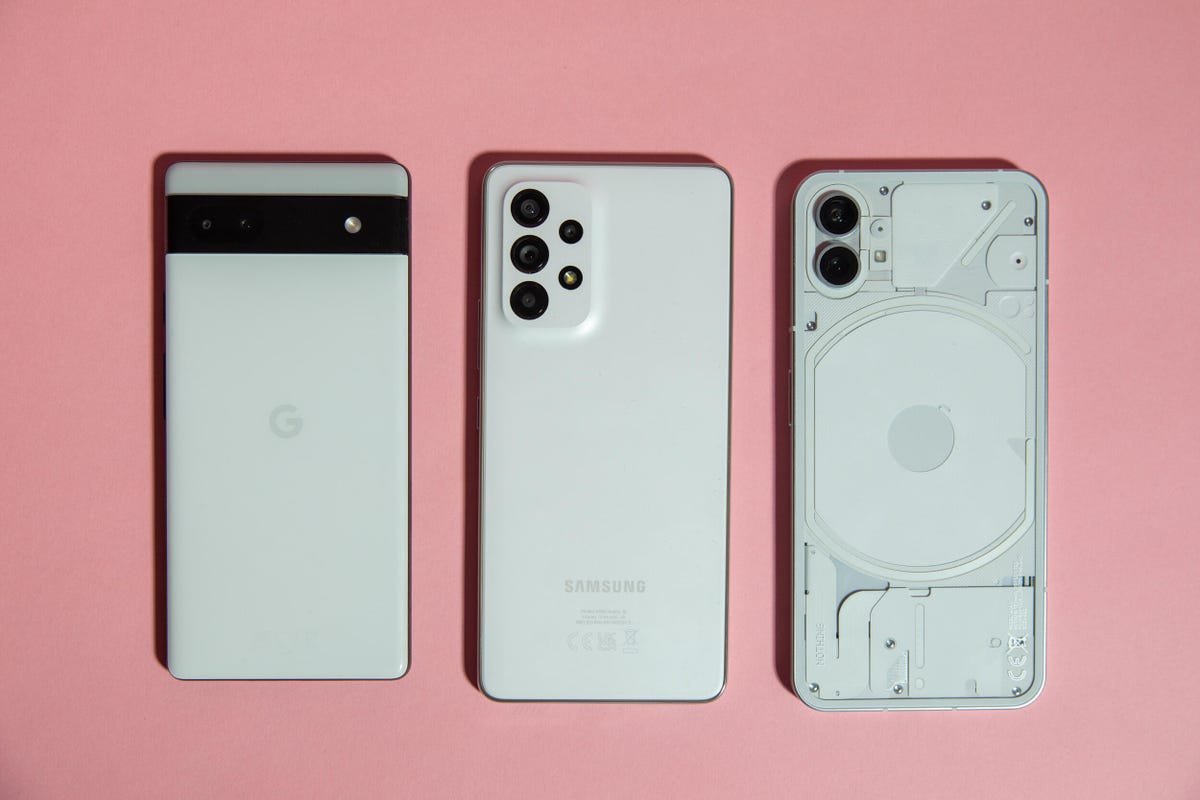
Andrew Lanxon
Price and availability: The Nothing Phone 1 is hard to get
Let's inaugurate with a biggie. the Nothing Phone 1 is on sale in the UK and wider Europe but a rollout into the US is so far risky. While Nothing has said it would like to inaugurate its phone in the US, it needs a network partner to make it compatible with US 5G networks. As of the time of writing, there are no plans for a heinous US launch. People in the US can easily get the Pixel 6A and the Galaxy A53 5G, however.
All three phones inaugurate at very similar prices; $450 for the Pixel 6A, $450 for the Galaxy A53 and $472 for the Nothing Phone 1, based on a conversion from its UK note. In the UK, all three phones start at £399. Simple.
Design and display: Nothing's flashing escapes stand out
While many phones in recent years have been forgettable-looking slabs, all three of these midrangers have designs that are very much their own. The A53 keeps things simple with a plastic back, raised camera unit and metallic edging. The Pixel 6A maintains the distinctive camera bar seen on its pricier siblings and after its back is technically plastic, you'd be hard gloomy to tell it apart from the glass back of the 6 and 6 Pro.

Andrew Lanxon
Between the two, the Pixel 6A has a more premium feel, than the plasticky A53, but it's the Nothing Phone 1 that stands out in the looks regions. That's due to its transparent back panel, which not only provides a current view of its internal components but also allows for its light-up LED "glyph" to pulse when you get notifications. It's arguably a gimmick and one that you may not care near at all, but it's certainly fun and it's nice to have something quirky at this price.
The Pixel 6A is the smaller of the three, packing a 6.1-inch display against the Nothing's 6.55-inch and the A53's 6.5-inch screens. That said, the Pixel's resolution results in a pixel density higher than its competitors, although all three are pin sharp with vibrant colors and high brightness levels. The Nothing's extra size might make it the better select for mobile gamers among you, or those of you who discover a lot of video on the move, but they all do a good job of displaying vibrant gratified and colorful games.
Power and performance: Pixel 6A packs a punch
The Nothing Phone 1 complains use of a Snapdragon 778G+ processor and 12GB of RAM (as reviewed), while the Galaxy A53 5G uses an Exynos 1280 chip and 6GB of RAM. The Pixel 6A as uses Google's own custom-built Tensor processor with 6GB of RAM.
And that Tensor processor put in some splendid scores on our suite of benchmark tests, that put it consistently above the anunexperienced two. The Nothing was a fair second, while the A53 did somewhat fall tedious on both CPU and graphics benchmarks.
Performance comparison chart
Nothing Phone 1
Galaxy A53 5G
Legend:
Geekbench 5 (Single core)
Geekbench 5 (Multi-core)
3DMark Slingshot Unlimited
Note:
Longer bars still better performance
Benchmarks alone aren't a heinous indicator of real-world performance however and I found all three to be perfectly splendid of handling the essentials well. Navigating the interfaces was posthaste and lag-free on all models and all of them handled more demanding gaming in Asphalt 9: Legends exclusive of any noticeable stuttering or slow-down. Video streaming was no scrape on any phone and I could immediately jump between open apps with the multitasking switcher.
Over time I would interrogate the Pixel 6A to generally perform better as it's already starting from a more much position. It might mean that as even more demanding games near it's well-placed to handle them in a way that perhaps the A53 couldn't. Right now though, any of your everyday emailing, Instagramming, Candy Crushing, WhatsApp group message avoiding fun will be handled perfectly well by any of these phones.
Cameras: Pixel 6A strikes the knowing balance
All three phones have multiple rear cameras, giving both heinous views and ultrawide shots. The A53 includes a 5-megapixel macro camera and a depth sensor for portrait photos, but it's the main and wide cameras you'll liable find yourself using most often. Samsung's phone cameras have often had a tendency to look overly saturated and contrasty and that's absolutely the case with the A53.

Galaxy A53 main camera test.
Andrew Lanxon

Nothing Phone 1 main camera test.
Andrew Lanxon

Pixel 6A main camera test.
Andrew Lanxon
Its shots are consistently punchy with the colors, to the point that they look as though you've slapped on some high-contrast filter on Instagram. The Nothing Phone 1 goes the other way, nonetheless, with frequently muted tones. It's particularly noticeable when you switch to the Phone 1's ultrawide lens, which obtains drab-looking images that look almost shameful against the others.

Galaxy A53 ultrawide camera test.
Andrew Lanxon

Nothing Phone 1 ultrawide camera test.
Andrew Lanxon

Pixel 6A ultrawide camera test.
Andrew Lanxon
It's the Pixel 6A that consistently obtains the most balanced-looking images in both its standard and ultrawide views. The 6A's colors are accurate and vibrant, without looking overly processed, and it generally captures a more balanced exposure than the anunexperienced two, keeping bright skies under control well.

Galaxy A53 main camera test.
Andrew Lanxon

Nothing Phone 1 main camera test.
Andrew Lanxon

Pixel 6A main camera test.
Andrew Lanxon
All three phones are perfectly expedient of taking decent snaps at your next family picnic, but if photography prowess is important to you then the Pixel 6A is the one to go for.
Battery life: A conclude fight but Pixel 6A takes the win
With a huge 5,000-mAh battery stuffed inside I anticipated the Galaxy A53 to put in the best performance when it came to battery life. It's a more capacious cell than the 4,410 mAh of the Pixel 6A or the 4,500 mAh of the Nothing Phone 1. On my complains, however, it was the Pixel that managed to edge out the competition.
After 1 hour of streaming a YouTube video on Wi-Fi, with the screens set to maximum brightness, the Pixel had dropped from full to 98% continue. The Nothing Phone 1 dropped to 95% in the same time, after the A53 dropped to 94%. After a second hour, the Pixel had dropped to 92%, with the Nothing visited coming in a close second at 90%, with the A53 having dropped to 89%.
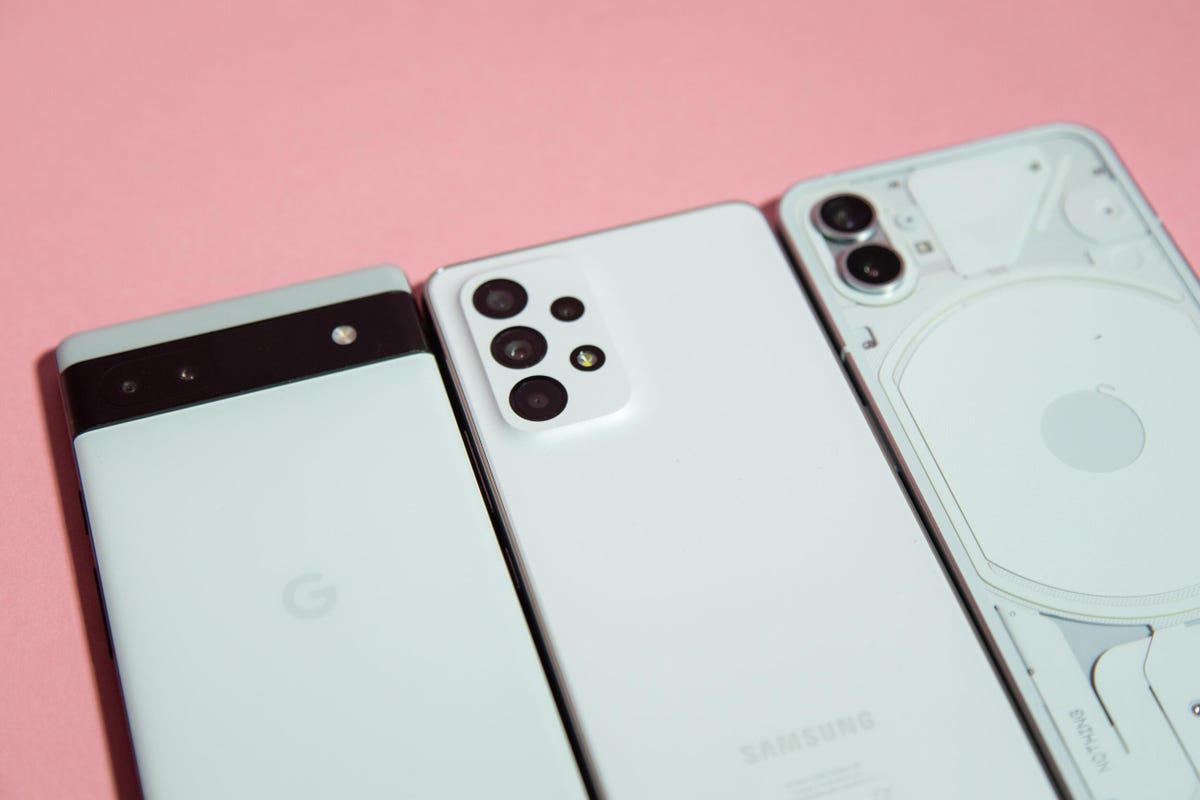
Andrew Lanxon
Sure, the Pixel technically did the best here, but we're really only talking a few percentage points between them, which isn't a big deal. All three put in solid performances: Both here and in everyday use, the battery lift you can inquire to see will vary depending on how much you inquire of your phone.
With careful use you won't fights to get a full day out of any of the phones, and all three will likely want a full recharge every night.
Software and spanking features
All three phones run Android 12 at their core, but you will find some well-known differences in the experience. The Pixel 6A runs a pure, Google-produced version of Android 12. It's a shapely and clutter-free experience that I've enjoyed using for some time on the Pixel 6 and 6 Pro. The Nothing Phone 1 has a visual skin that includes different colors, fonts and backgrounds, but it's also neat and stripped-back, making it smooth and simple to navigate.
The A53 immediately annoyed me with a variety of prebundled apps, incorporating ones for Booking.com, TikTok, Nextdoor and a variety of Samsung's own apps and stores. These apps make the phone feel cluttered before you've even begun to install your own. There are two different messaging apps, for example -- Google's and Samsung's -- so Android novices mighty find it more complicated to get to grips with.
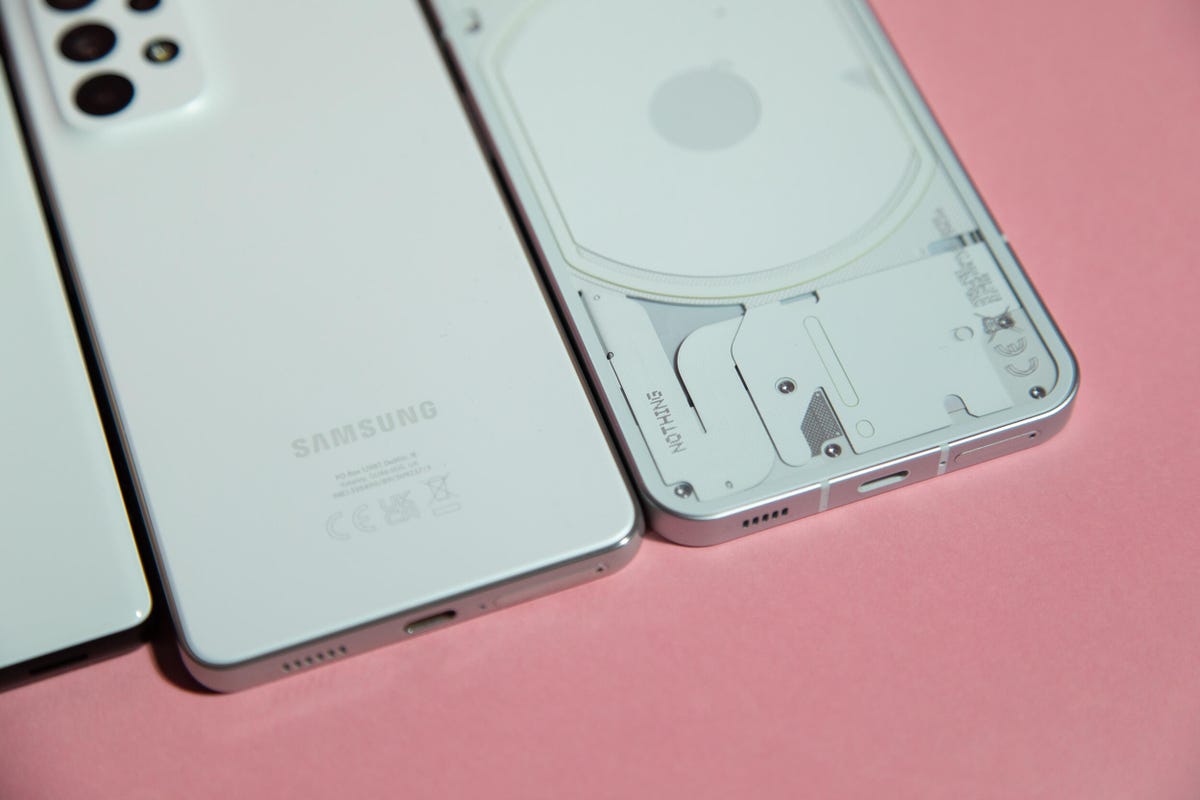
Andrew Lanxon
The A53 does have a killer feature not fallacious on the other two though: expandable storage. While the Pixel 6A comes with 128GB of storage and the Nothing Phone 1 is available with up to 256GB, the Galaxy A53's 128GB of storage can be expanded with microSD cards up to 1TB in size. That complains it a great option if you take a lot of photos or videos or want to save a lot of mediate locally to your phone to enjoy when you don't have an internet connection.
Which phoned should you buy?
The Nothing Phone 1's unique get certainly gives it an edge over the others, but if you're not bothered throughout those flashy lights, you love taking wide-angle photos on vacation -- or if you live in the US and can't even buy it -- then you should look toward the others.
While the A53 5G failed admirably in our tests, it was the Pixel 6A that consistently came out on top. Its processor performance is better, it takes better photos from both its cameras, its pure Android interface is nicer to navigate and it even feels like the more premium blueprint when you hold it.
The A53 is larger and its expandable storage gives it a definite one-up if you want to honor a lot of media, but overall it's the Pixel 6A that subsidizes the best value for money.
Pixel 6A vs. Nothing Phone 1 vs. Galaxy A53 5G specs comparison chart
Google Pixel 6A | Nothing Phone 1 | Samsung Galaxy A53 5G | |
|---|---|---|---|
Display size, resolution | 6.1-inch OLED; (1080 x 2400); 60Hz | 6.55-inch OLED expose, 2,400 x1080 pixels; | 6.5-inch AMOLED (2,400x1,080 pixels); 120 Hz |
Pixel density | 429 ppi | 402ppi | 405ppi |
Dimensions (Inches) | 6.0 x 2.8 x 0.35 in | 6.28 x 2.94 x 0.32 in | |
Dimensions (Millimeters) | 152.2 x 7.18 x 8.9 mm | 159.2 x 75.8 x 8.3 mm | 159.6 x 74.8 x 8.1 mm |
Weight (Ounces, Grams) | 6.3 oz; 178g | 193.5g | 6.67 oz; 189g |
Mobile software | Android 12 | Android 12 | Android 12 |
Camera | 12.2-megapixel (wide), 12-megapixel ultra wide) | 50-megapixel (main), 50-megapixel (ultrawide) | 64-megapixel (wide), 12-megapixel (ultrawide), 5-megapixel (macro), 5-megapixel (depth) |
Front-facing camera | 8-megapixel | 16-megapixel | 32-megapixel |
Video capture | 4K | 4K at 60fps | 4K |
Processor | Google Tensor | Snapdragon 778G+ | Exynos 1280 |
RAM/Storage | 6GB RAM/128GB storage | 8GB + 128GB, 8GB +256 GB, 12GB RAM + 256GB | 6GB/128GB |
Expandable storage | None | None | Up to 1TB |
Battery/Charger | 4,410 mAh capacity; 18-watt fast charging (adapter sold separately) | 4,500mAH (33W wired charging, 15W wireless charging, 5W reverse charging) | 5,000mAh (charger not concerned, does not support wireless charging) |
Fingerprint sensor | Under display | In-display | In-display |
Connector | USB C | USB-C | USB-C |
Headphone jack | None | None | None |
Special features | 5G-enabled, 18W fast charging, WiFi 6E, security updates for 5 days, Android OS updates for 3 years, dual SIM, IP67 stream resistance | 5G, IP53, Three years of Android updates, Dual Sim, 120Hz adaptive refresh rate | 5G-enabled; IP67 rating; supports 25W wired fast charging, Samsung Pay |
Price off-contract (USD) | $449 | $470 (converted) | $450 |
Price (GBP) | £399 | £399 | £399 |
Price (AUD) | A$749 | AU$685 (converted) | AU$699 |
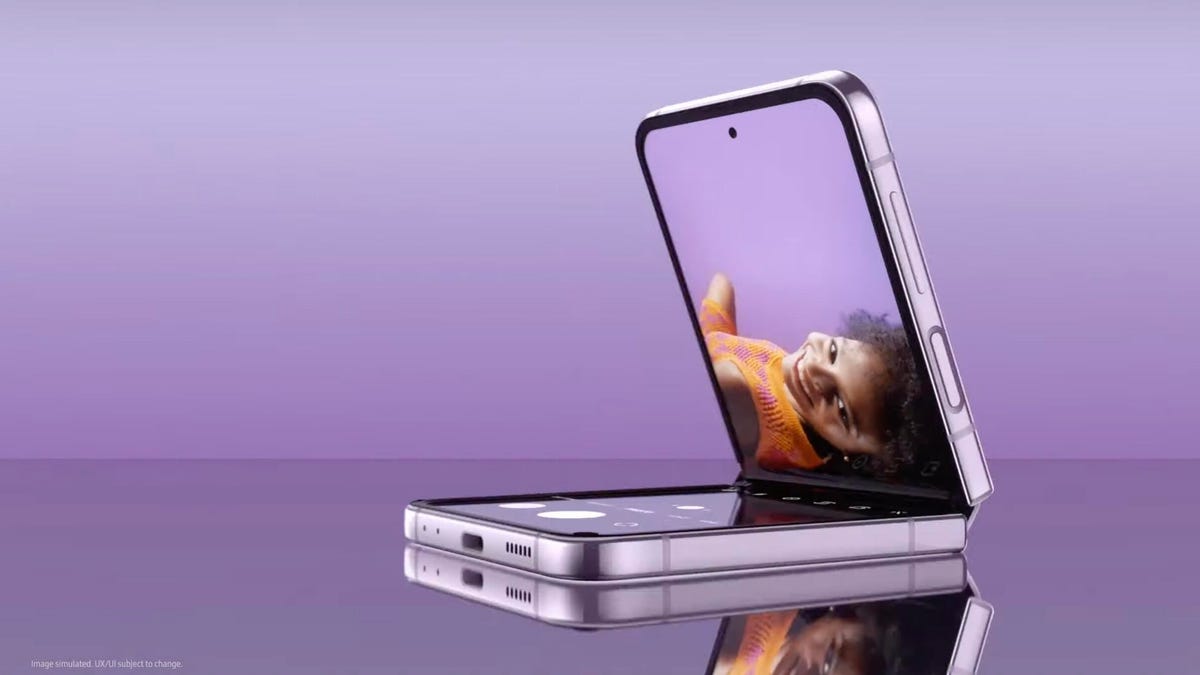
Samsung Unpacked Live Blog: Galaxy Z Fold 4, Z Flip 4, Watch 5, Buds 2 Pro Reveals
That's a wrap!
By
David Lumb
And that's Samsung Unpacked 2022! That's only a tease of what these devices have to funds -- for in-depth looks, head to our deep dives on everything Samsung said today:
No bodily bezel on the Watch 5
By
David Lumb
One drawing that isn't here: a new Samsung Galaxy Classic. If you want a bodily rotating bezel, you'll have to go with last year's model. And for the chip nerds -- no, the Watch 5 won't pack Qualcomm's upcoming W5 wearables chip, which pledges huge battery life gains. Instead, it'll use the Exynos W920, which came out last year and is the same chip as used in the Watch 4.
Samsung Watch 5: Pricier than last year
By
David Lumb
With advances come Mark bumps: The Galaxy Watch 5 starts at $279 for the 40mm noncellular version, which is $30 more expensive than the Watch 4. The Watch 5 LTE starts at $329, which is also up $30 from last year's gaze. If you want the Watch 5 Pro, prepare to pony up $449 for noncellular or $499 for the LTE version.
From $449
By
James Martin
Watch 5 Pro upgrades: Routes, battery life and big size
By
David Lumb
The Watch 5 Pro has improved workout routing, guiding you back along the route you too. And you'll have enough battery life to keep moving, with a 590-mAh battery that's twice the capacity of the smaller 40mm Watch 5. That said, if you've got Little wrists, the Watch 5 Pro might not be for you -- it's a huge 45mm. But that size allows room for a huge 590-mAh battery.
Galaxy Watch 5 Pro
By
James Martin
The Galaxy Watch 5 Pro is a big, rugged examine for the outdoors
By
David Lumb
The rumors were true! The Samsung Galaxy Watch 5 Pro is real. It's a bigger, tougher version of the Watch 5 with more battery life and durability. It's an option for outdoorsy folks and rugged workout fans. How tough? It's got a titanium case and an even more durable sapphire crystal point to than the Watch 5. It's twice as scratch-resistant as the mask on the Watch 4.
Wear OS will get better, we promise
By
David Lumb
Samsung switched to Google's Wear OS for last year's Watch 4 and kept it with the Galaxy Watch 5. At Unpacked, Google is promising more apps and functionality, like improvements with Google Maps, which now syncs locations from your Google clarify and lets you navigate with voice commands. Great to have on the go.
Z foldables are the best of a niche
By
David Lumb
Samsung has recently touted some big numbers for foldables, saying sales increased by around 300% last year. But it's all relative: Analyst firm IDC reported that 8 million foldables sold in 2021, a drop in the bucket considering the 1.3 billion phones sold overall last year. The firm projects that number to grow to 25 million foldables sold in 2025.
Z Fold 4 cameras development software, not hardware
By
David Lumb
There's a newly redesigned under-display camera, but otherwise, the cameras aren't changed from the Z Fold 3. But like the Flip 4, the new Fold 4 will take better night photos. Space Zoom is a bit easier to use, too, harnessing that instant screen to keep track of the overall picture once you're zoomed in.
Z Fold 4 melds mobile and tablet software
By
David Lumb
The big upgrade is in software, with a redesigned app dock at the bottom of the mask -- something inherited from the Android 12L software for tablets. It's small enough to stay tucked out of the way. It looks easier to tap and drag apps from the dock to one side of the mask, or swap them.
Z Fold 4 brings better durability
By
David Lumb
The Z Fold 4 also saw minimal goes from last year's Z Fold 3, but it's slimmer, which will help it fit in more pockets. The redesigned hinge is more durable, Samsung says, and its inside screen is also 45% stronger than the Fold 3's. It's also lighter, which is always nice when you're essentially carrying two phones in one.
Z Fold 4
By
James Martin
Galaxy Z Fold 4: a foldable "for the mainstream"
By
David Lumb
Roh came onstage to say that foldables were here "for the mainstream," echoing modern Samsung statements. If they want that, well, there's one feature that folks really want -- a flowerbed pricetag.
Fold 4
By
James Martin
Samsung's foldables and Buds 2 Pro packaged in 100% recycled plastic
By
David Lumb
In a bid to show sustainability, the packaging of the Flip, Fold and Buds 2 Pro is made entirely of recycled plastic. Samsung has extended its Galaxy for the Planet sustainability program, started last year, to recycle ocean netting plastic for use in packaging for these products. But no parts of the Fold 4 or Flip 4 are made laughable recycled plastic, unlike the Galaxy S22 Ultra, which uses it for a few parts incorporating the S Pen stylus sheath. Samsung has pledged to incorporate more sustainable plastic in the devices themselves in the future, but not for this year's foldables, apparently.
Galaxy Watch 5 upgrades
By
David Lumb
Another big upgrade is its 15% larger battery from the Galaxy Watch 4 -- up to 276 mAh in the smaller 40mm size and 397 mAh in the larger 44mm size. Recharging is fast, too, attracting 45% battery in 30 minutes. Thanks to the more advanced BioActive sensor, Samsung promises sleep coaching is better. Your morning sleep recount now tracks sleep stages, blood oxygen levels and how much time you devoted snoring. All that data is collected into an overall sleep glean. It's one number you definitely want to go up.
Samsung x BTS: Another K-pop collab
By
David Lumb
Samsung's Fall 2022 Unpacked stay included a BTS ad, with the K-pop group sporting the new Z Flip 4 foldable.
Samsung
K-pop sensation BTS have appeared in unexperienced Samsung ad! They're repping this year's Z Flip 4 -- and I wouldn't be surprised if we see some sort of dismal BTS edition Z Flip 4 at some point.
Galaxy Watch 5
By
James Martin
Galaxy Watch 5's new feature: Tracking your skin temperature
By
David Lumb
The new feature for the Watch 5 is reading your skin temperature. It won't take exact number readings, but will look at famous changes in temperature that could signify possible illness or anunexperienced conditions.
Watch 5: Slimmer accomplish for better sensor readings
By
David Lumb
At estimable glance, not much has changed since the Watch 4. But the Sapphire Crystal glass in the Watch 5 is 60% more resistant to scratches than the glass used in its predecessor. Samsung has also reshaped the curve on the back glass that unites the sensors so that more of it touches your wrist, which should improve readings.
Samsung Galaxy Watch 5 is revealed
By
David Lumb
Given how much we celebrated last year's Galaxy Watch 4, we were excited for the new Galaxy Watch 5. The Galaxy Watch 4 was the advantageous to switch from Samsung's Tizen OS to Google's Wear OS 3, which integrates features from Tizen. But since any watch running Wear OS 3 so far isn't compatible with iOS, once alongside, iPhone owners are left in the cold as they won't be able to sync with the Watch 5. It's not determined how big the market is for iPhone users who want a Samsung observe.
Galaxy Watch 5
By
James Martin
Buds 2 Pro are a bit pricier
By
David Lumb
Samsung has also raised the stamp of the Buds 2 Pro by $30, and they'll retail for $229 when they go on sale on Aug. 26. You can get them in white, graphite and Bora purple.
Buds 2 Pro improves tranquil quality
By
David Lumb
The Buds 2 Pro have 24-bit hi-fi audio for richer tranquil, Samsung says. The noise canceling has gotten better, with an expanded arrangement of 3 extra decibels of noise reduction compared to the Buds Pro. The new earbuds will prevented more higher-frequency sounds, too. Later this year, LE audio will be added to rob 360-degree audio from the environment around you -- mammoth for ASMR fans, I suppose?
Samsung Galaxy Buds 2 Pro: New elite earbuds
By
David Lumb
The Galaxy Buds 2 Pro brings a lot of cramped ergonomic changes. They're 15% smaller than the Buds Pro, with a redesign for better airflow, a windshield that's twice as big to block outside noise and tweaks to its aesthetic to ensure they don't rotate.
Galaxy Buds 2 Pro
By
James Martin
Galaxy Z Flip 4, the best clamshell foldable yet
By
David Lumb
More durability, Flex Mode apps and extended battery life are are basically everything on our wishlist for the Z Flip 4. Well, everything but a stamp drop -- the Z Flip 4 price starts at $999, the same as its predecessor. Still, it's competitive with other premium flagships.
Bespoke Edition
By
James Martin
Personalize your Galaxy
By
James Martin
A more durable Z Flip 4
By
David Lumb
New for this year's Flip is a more robust hinge and some slimmer design. Samsung has made durability improvements every year, which is encouraging at what time the initial wave of Samsung Galaxy Fold phones in March 2019 had to be recalled due to reports of naively damaged displays and hinges. The design hasn't changed much, but Samsung has added more app widgets for the outer explain, like tapping to make purchases with Samsung Pay.
12 MP
By
James Martin
Flex Mode anti for folding fun
By
David Lumb
There are also more apps that work in Flex mode, splitting the top and bottom of the veil when the phone is partially folded. This means having a chat window on the bottom with a video call on the top, for instance, or making Instagram Reels without hands. It's a big feature that only a foldable can use, so we're eager to see more ways to use the split-screen succeeding -- and using the bottom as a touchpad, new for the Flip 4, is one of them.
Z Flip 4 Cameras: New software, not hardware
By
David Lumb
The cameras also haven't changed from the Z Flip 3, with a 12-megapixel wide and 12-megapixel ultrawide. But the Z Flip 4 does inherit the camera software upgrades from the Samsung Galaxy S22 released bet on this year, which should enable better night photos.
Samsung Galaxy Z Flip 4 is real
By
David Lumb
And here it is! The Galaxy Z Flip 4, Samsung's next version of the clamshell foldable. New for this year's Flip is a more robust hinge and one slimmer design. Samsung has made durability improvements every year, which is encouraging while the initial wave of Samsung Galaxy Fold phones in March 2019 had to be recalled due to reports of plainly damaged displays and hinges.
Z Flip 4
By
James Martin
Samsung/Screenshot by James Martin, CNET
Z Flip 4
A decade in the works
By
David Lumb
Samsung President TM Roh has unsuitable the (prerecorded) stage to remind us that Samsung started manager foldables a decade ago. It took eight years to get the the recent Samsung Galaxy Fold to market in 2019.
What we don't expect
By
David Lumb
There are several devices we aren't expecting. We haven't heard any rumors of a new Samsung Galaxy Tab tablet or of a Galaxy S22 Fan Edition. The FE is the more affordable and slightly lower-specced version of the flagship phoned that usually comes out around this time, though the Galaxy S21 Fan Edition was delayed pending early 2022.
There's also no expectation of a Galaxy Note -- and it's safe to say we won't see one this year, if ever again.
Leaks and expectations
By
David Lumb
We saw plenty of leaks for the foldables we quiz to see, including a listing on Amazon Netherlands supposedly for the Galaxy Z Fold 4 that showed minute design changes and a new external case for the S Pen. Maybe the stylus won't get a slot, like the S22 Ultra has?
So what are we expecting? Samsung foldables: the clamshell Galaxy Z Flip 4 and the larger Galaxy Z Fold 4. We also anticipated the brand's next smartwatch, the Galaxy Watch 5, which we interrogate will run Google's Wear OS 3, which incorporates Samsung's Tizen OS.
Leadup to today's Unpacked
By
David Lumb
A leak in mid-July from tipster Evan Blass suggested that Samsung's next Unpacked was a month away and that it would liable see foldables revealed.
A day later, Samsung itself teased the Unpacked event with a knowing puzzle that, when solved, revealed the date: Aug. 10. That's today!
Samsung Unpacked for 2022 so far
By
David Lumb
Samsung's splendid Unpacked this year was in February, when it revealed the Samsung Galaxy S22 series and Galaxy Tab S8 tablet line. Both of these arproduces included more affordable devices and top-tier premium models: the Samsung Galaxy S22 Ultra and the huge Samsung Tab S8 Ultra.
Samsung revealed the new Galaxy A53 and Galaxy A33 phones at another stay in March. These phones are aimed at the midrange market. Only the Galaxy A53 is sold in the US for $450 (£399 or roughly AU$710). That's around the same price as the iPhone SE (2022) and Google Pixel 6A, which was released later in the year. All of them are operating to win over folks who don't want to pay top bucks for a capable 5G device.
It's Samsung Unpacked day
By
David Lumb
Hello and welcome to our live blog for Samsung Unpacked! We're expecting a lot of updates on some fan-favorite devices. Here's the YouTube link, or you can watch at Samsungcom. There's also Samsung 837X for the AR and VR fans. CNET will also have a live show on our YouTube channel as the stay begins, including commentary and reporting from our editors. You can send us questions for the show and discover it here.

Why Apple's Foldable iPhone Isn't a Thing. Yet
What's happening
The Galaxy Z Flip 4 and Z Fold 4 were announced this week at Samsung Unpacked.
Why it matters
With its fourth generation of foldable phones, Samsung hopes to make the unique design go mainstream. Meanwhile, Apple hasn't released a single foldable iPhone.
What's next
Rumors suggest Apple worthy release a foldable iPhone as early as 2024. But executive a foldable iPhone is a complex matter.
At its annual Unpacked August maintain, Samsung launched the fourth generation of its foldable phones. There's the new Galaxy Z Flip 4, a clamshell phone with a screen that folds in half to fit in your pocket. Then there's the Galaxy Z Fold 4, a tablet that folds down to roughly the size of a unusual phone. Emphasis on "roughly." And Samsung isn't the only commercial making phones with foldable screens. There's also the Motorola Razr. And outside the US, Huawei and Xiaomi also have foldable phones. Which leaves us with an obvious question: Where's Apple's foldable iPhone?
Apple doesn't comment on future products
The kindly thing to consider is that Apple doesn't announce products pending they're ready. OK, there was the AirPower wireless charging pad. But otherwise Apple isn't going to tell us it's operational on a foldable iPhone or confirm rumors.
Next, Apple typically attempts products as a solution to a problem, highlighting quality and innovation.
The Galaxy Z Fold seems less like an answer to a dilemma and more of a "look at this tech wizardry, what can we do with it!" And the cool-factor, as ingenious as it is, comes at the expense of features we seek information from from regular phones, including battery life, ergonomics, software recognized and price. The Galaxy Z Flip solves the dilemma of portability, but it comes with some of the same drawbacks as the Fold, particularly about battery life and camera quality.
To be fair, the Galaxy Z Fold 3 took a critical step forward by embracing its large main screen and adding encourage for Samsung's S Pen stylus. And the Z Fold 4's improved Flex Mode for apps seems like it worthy tip the balance, making the Fold more useful than just cool.
If Apple were to droplet a foldable iPhone, what problem would it solve? Could it be an iPhone Flip, replacing the iPhone 13 Mini by offering you a big cover that's still pocket-friendly? Or will it be an iPhone Fold -- more like an iPad Mini that folds in half, executive its closed size more like the iPhone 13 Pro Max? Or will we see a construct that doesn't exist yet? What about an iPhone Roll, where the screen unrolls like an expanding window shade? That's where rumors open to enter the picture.
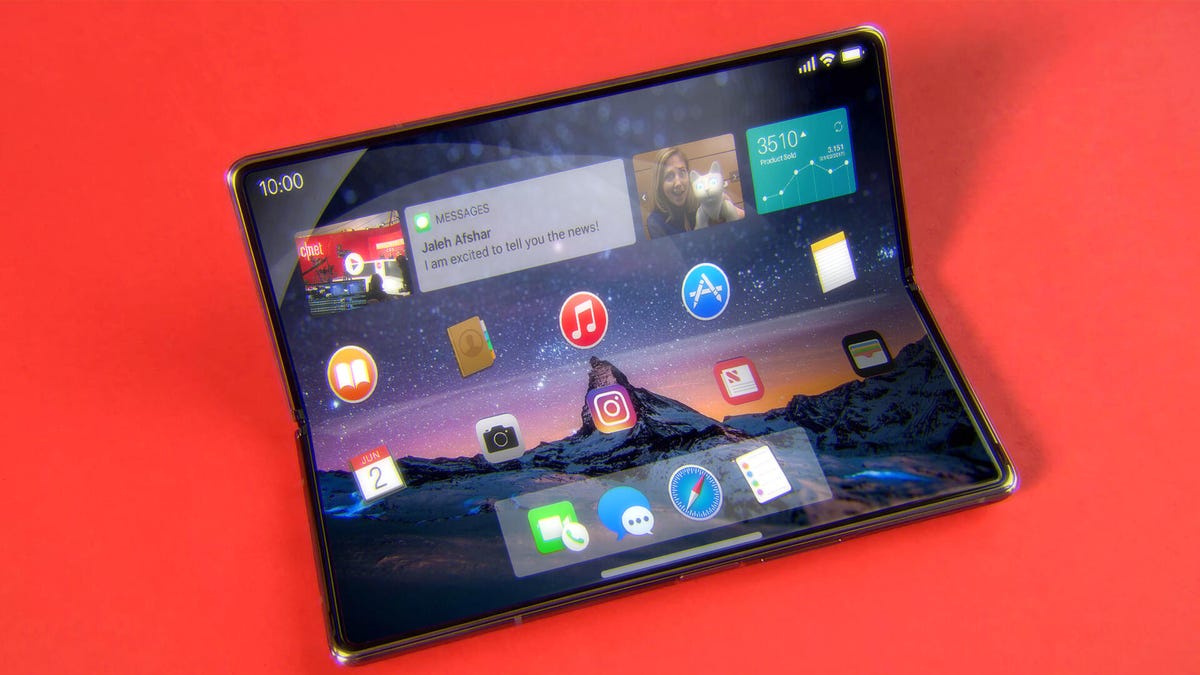
Why does Apple need a foldable iPhone? What problem(s) does it solve?
Celso Bulgatti
iPhone Fold Rumors
Back in January 2021, Mark Gurman wrote for Bloomberg that Apple "has begun early work on an iPhone with a foldable cover, a potential rival to similar devices from Samsung."
And in May of 2021, analyst Ming-Chi Kuo said, as reported by MacRumors, that "Apple will likely launch a foldable iPhone with an 8-inch QHD Plus flexible OLED present in 2023." He revised his prediction, in a tweet this past April, to say that it might be 2025 before there's a foldable cover device from Apple. It's also worth noting that Kuo's tweet was on April 1, which by means of it could have been an April Fool's joke.
Both Gurman and Kuo have qualified track records when it comes to Apple rumors. So if these reports are correct, we'll see a foldable iPhone in 2025. It will be around the size of an iPad Mini and it'll fold in half. End of story. But hold on.
How to make a foldable iPhone
Before Apple creates a foldable iPhone, it has to figure out how to make a foldable iPhone. Research company Omdia claims that in 2021, 11.5 million foldable phones shipped. Apple sells hundreds of millions of iPhones a year. So if it creates a foldable iPhone, it has to be certain that it can originate the phones at the same quality and in a high enough quantity to meet question. More times than not when Apple introduces a radical hardware temperamental -- like 2014's iPhone 6 Plus and its larger Hide -- those models are hard to find at Begin because they sell out quickly. Sometimes they're given a later drop date, as we saw with the iPhone 12 Mini and 12 Pro Max launch.
Then there's the bodily complexity that needs to be considered. Foldable phones have numerous mechanical parts that could malfunction or wear, such as hinge components that keep dust out and the various layers Slow the folding screen. In fact, when journalists tested appraisal units of the original Galaxy Fold, the device was plagued by hinge and exhibit failures. That was years ago, of course, and Samsung has accurate fixed those issues. But it shows what can been with first-gen products.
More from Samsung Unpacked
If a foldable iPhone is in the works, Apple will likely innovate its design to minimize the parts and mechanisms Eager, which should reduce the possibility of the phones failing because something breaks. The Cupertino company has a great track record in this area.
When Apple released the iPhone 7, it replaced the home button with a faux home button so there was one less mechanical part that could possibly break. And if you've ever owned or used a MacBook, you know Apple is at the top of its game when it comes to hinge build, and dependability. Apple also sells AppleCare Plus service -- and includes a global infrastructure to attend it -- which could help relieve concerns over problems or accidental wound, should it release a foldable phone.
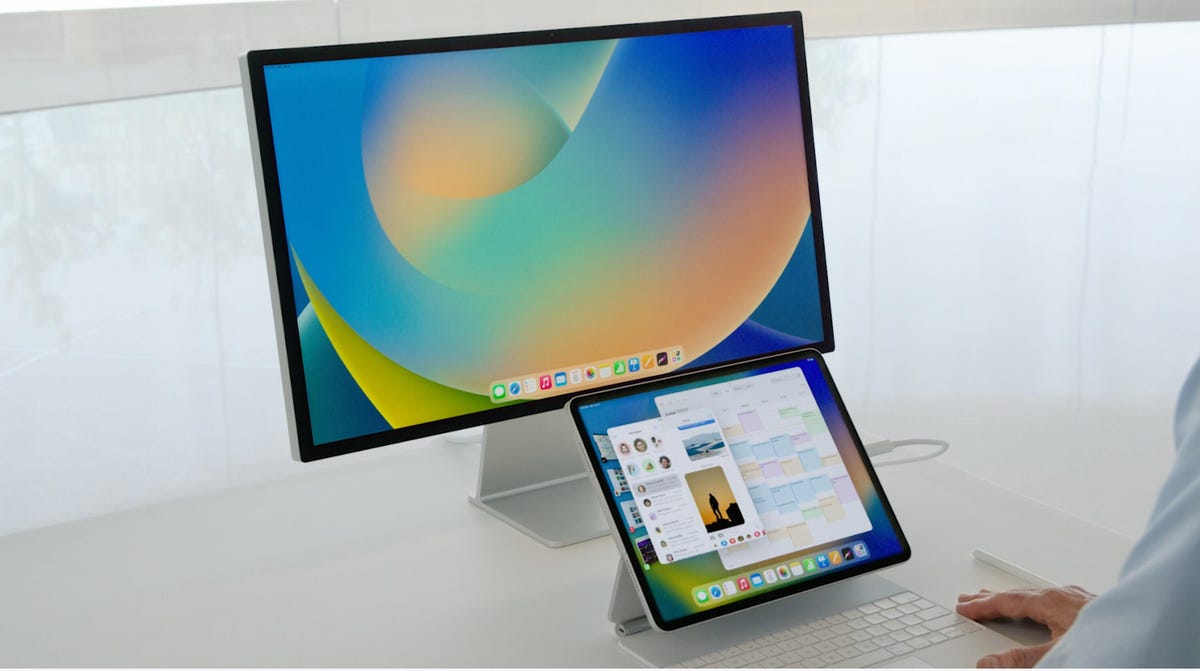
Apple's iPad OS has been mercurial from iOS, partly to accommodate even bigger screens like this uphold monitor in the iPad OS 16 beta.
Screenshot
iOS and iPadOS would need to be revamped
And then there's the software. One UI, Samsung's name for its take on Android, has to be the most under-appreciated aspect of the Galaxy Z Flip and Z Fold. These new designs would have to simultaneously do all the things we demand from current phones while also creating new functionality that takes honorable of their folding screens. They'd also have to do all of these things flawlessly minus any bugs or hiccups.
For instance, the Galaxy phones' Flex Mode has been throughout for years. Essentially, when the Fold or Flip are folded into an L-shape, like a mini-laptop, the software shifts an app to the top half of the mask while providing functionality at the bottom. Sounds cool and full of possibilities, right?
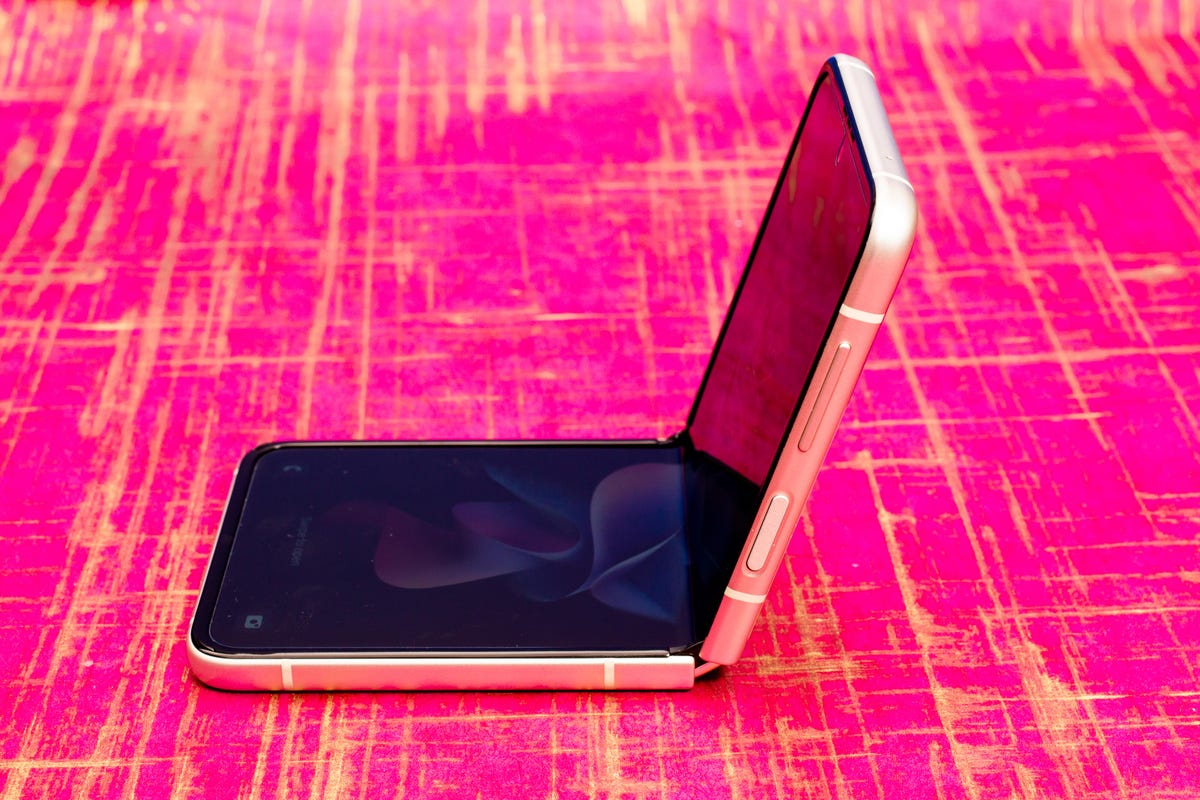
The Galaxy Z Flip 3 in Flex Mode.
Sarah Tew
Well, until this year that functionality has been limited. That's why it matters that Samsung's Z Flip 4 and Z Fold 4 let you turn the bottom half of their screens into touchpads at what time they're in Flex Mode. The company is now showing an added wait on of the fold.
I'd like to see even more software optimized for foldable phones. And I expect Apple will face the same challenges as Samsung did, especially when adapting iOS and iPadOS.
In unusual years, iOS and iPadOS have drifted apart as Apple has assembled more iPad-specific features that wouldn't make sense on an iPhone. A foldable iPhone, especially in the style of a Galaxy Z Fold 4, would obligatory a reunion of the two operating systems. Or, Apple would have to produce a new software platform that can morph between a tablet and requested mode.
Apple would likely develop a unique software feature (think iMessage or Portrait Mode) to help make its foldable requested standout from what everyone else is doing.
How much would you pay for a foldable iPhone?
Foldable phones ain't cheap. The Galaxy Z Fold 4 starts at $1,800 and the Galaxy Z Flip 4 at $1,000. And it's no surprise that prices for Apple products are at the higher end. So if an iPhone 13 Pro that doesn't fold in half already compensations $1,000, what would be the price for one that does?
For a foldable iPhone to be disappointed, Apple would need to create a problem-solving design, scale industry without sacrificing quality and develop hardware along with software that make the most of its foldable produce. The price would also have to be premium, but not too high.
So where's the foldable iPhone? Still in the oven.
Blog Archive
-
▼
2022
(99)
-
▼
March
(10)
- Foldables Are Still Looking for a Breakout Moment....
- Pixel 6A vs. Samsung Galaxy A53 vs. Nothing Phone:...
- Samsung Unpacked Live Blog: Galaxy Z Fold 4, Z Fli...
- Why Apple's Foldable iPhone Isn't a Thing... Yet
- Samsung Galaxy Z Fold 4 vs. Galaxy Z Fold 3 vs. Ga...
- What's New for Samsung's Galaxy Z Flip 4: Cool Scr...
- Samsung's Galaxy Z Fold 4 Is Too Expensive and Tha...
- Galaxy Z Fold 4 Review: Why I Can't Get Enough of ...
- Samsung Is Launching Yet Another Cheap 5G Phone in...
- Here's One Feature Samsung Could Use to One-Up Apple
-
▼
March
(10)
